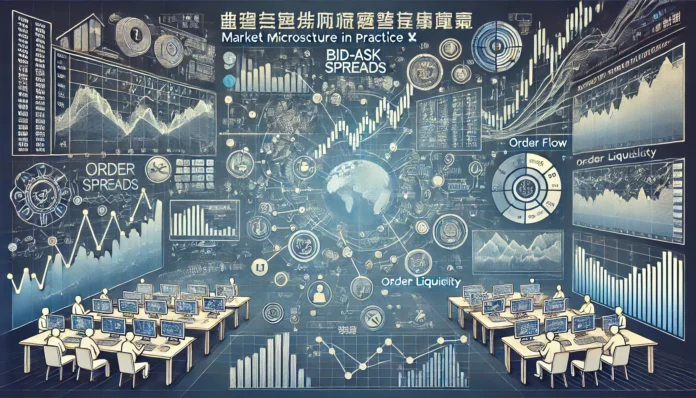Market microstructure in practice 中文 is all about how trading works behind the scenes, especially in Chinese markets.
Ever wondered how trades actually happen?
Or why prices change so fast?
That’s where market microstructure comes in. It’s like the nuts and bolts of a machine that runs the stock market.
Traders, investors, and researchers want to know more about how markets work so they can make smarter decisions.
Why Should You Care About Market Microstructure?
Most people think of stock prices going up and down, but have you ever asked, why does the price move?
The market microstructure is what controls how orders get filled, how fast trades happen, and what influences prices.
Here’s why it matters:
- For traders, knowing market microstructure helps you place better trades.
- For investors, it helps you understand why your investments might be moving the way they are.
- For researchers, it opens up a world of data to analyze market efficiency.
In Chinese markets, especially, understanding the specific microstructure can give you a major advantage.
Real-Life Example: The Impact of Market Microstructure
Imagine you’re buying a stock.
You hit “buy,” and within seconds, the trade is complete. But behind that click, a lot is happening.
Brokers, exchanges, and market makers are all working together to make that trade happen.
In China, the market microstructure is unique due to government regulations, the speed of information dissemination, and how large investors behave.
Knowing these quirks can help you understand why stocks move the way they do, sometimes with lightning speed.
How Does Market Microstructure in Chinese Markets Differ?
The keyword “market microstructure in practice 中文” points specifically to Chinese markets.
Here are some key differences:
- Regulations: China’s stock markets have strict regulations that impact how trades are processed.
- Investor Behavior: Chinese investors tend to act in herds, meaning a large group might all buy or sell at the same time, influencing prices more dramatically.
- Speed: The speed of trading and the tools used in Chinese markets are slightly different from Western counterparts.
Understanding these key differences can help you trade smarter in Chinese markets.
Key Components of Market Microstructure
Let’s break down the essential components of market microstructure:
- Order Flow
This refers to how buy and sell orders enter the market. The balance between these orders moves prices. - Liquidity
More liquidity means you can trade faster without moving the price. Liquidity in Chinese markets is often concentrated in a few popular stocks. - Bid-Ask Spread
The difference between the price someone is willing to buy (bid) and the price someone is willing to sell (ask). A smaller spread means a more efficient market. - Market Makers
These are the players who ensure there are always buyers and sellers in the market, keeping things moving smoothly.
FAQs About Market Microstructure in Practice 中文
Q1: Why is market microstructure important?
Market microstructure helps you understand the mechanics behind how trades happen and why prices move.
It’s crucial for anyone who wants to make informed trading decisions, especially in specific markets like China.
Q2: Does market microstructure impact all stocks?
Yes, every stock in every market is affected by its microstructure. However, how much it impacts can vary based on liquidity, trading volume, and market regulations.
Q3: What role do regulations play in Chinese market microstructure?
Chinese markets are heavily regulated. This impacts everything from how orders are processed to who can trade certain stocks.
Q4: Can understanding market microstructure help me make better trades?
Absolutely. By understanding how the system works, you can time your trades better, avoid slippage, and predict price movements more effectively.
How to Navigate Market Microstructure Like a Pro
If you want to master “market microstructure in practice 中文,” here’s how you can start:
- Stay Updated: Keep an eye on any regulatory changes in the Chinese stock market.
- Watch the Liquidity: Focus on stocks that have high liquidity; these are easier to trade quickly and with less price impact.
- Learn from the Data: Research past trading patterns in Chinese stocks. Often, history can give you insights into future behavior.
Why Traders Need Market Microstructure Knowledge
Traders who understand microstructure have an edge over those who don’t.
Here’s why:
- You can spot trading opportunities faster.
- You can avoid bad trades by understanding when the market is thin or volatile.
- You’ll be able to read price movements with more clarity, knowing what’s driving them.
Wrapping It Up: The Importance of Market Microstructure in Practice 中文
When you understand market microstructure in practice 中文, you unlock a deeper level of knowledge about how trades happen, why prices move, and how to trade more effectively.
For anyone involved in the Chinese stock market, this understanding isn’t just a bonus; it’s essential.
By learning how Chinese markets function on a micro level, you can make smarter trading decisions and improve your overall success.
Market microstructure in practice 中文 can help you navigate the complexities of trading and investing in China with confidence.
Now that you know the basics, it’s time to put that knowledge into practice.
